LESSON 1: UNIT THREE
INFECTION CONTROL
Objectives 
- Review the principles of standard precautions.
- Know that facilities will have specific policies relating to infection control.
- Identify proper hand hygiene techniques.
- Identify additional methods of infection control
Refer to your textbook pg 191
Principles of Standard Precautions- Review principles of standard precautions, chain of infection, barriers to infection and ways to handle infectious waste.
Guideline for Isolation Precautions Click Here
Facility’s Employee Exposure Plan—Policies/procedures that relate to infection control.
- Review these policies. Ask questions to clarify and assure understanding.
Refer to your textbook pg 205 & 210
Handwashing—The single, most important action to protect yourself and your residents from the spread of infection.
Handwashing Video Click Here
How to wash Click Here

- Hands should be washed:
- After touching blood, body fluids, secretions, and excretions, and contaminated items regardless of whether gloves are worn.
- Immediately after gloves are removed.
- Before and after providing direct care such as bathing, perineal care, or oral care.
- After caring for resident with known infection.
- Before and after caring for or touching wounds.
- Between tasks on the same resident to prevent cross contamination of different areas of the body (working with different wounds).
- Before caring for resident susceptible to infection such as resident with impaired immune system.
- Before and after your work shift.
- Before and after you are using the restroom.

- Before and after you eat.
- One of the handwashing times most generally missed is when using tobacco. If you are outside smoking, please wash your hands when you return. The odor from the tobacco on your hands is very strong and for the residents you are caring forsake it is best to wash off that smell.
- After coughing, sneezing, using a Kleenex.
~~Can you believe--It is estimated that one out of three people do not regularly wash their hands, even after using the restroom. Let’s increase this statistic together and wash our hands!
- Hand washing technique
- Use warm, running water, keeping hands lower than elbows allowing water to flow toward fingertips.
- Use firm rubbing motion to clean all surfaces of wrists, hands, fingers lower arms, knuckles, and nails. Liquid soap is usually provided from a dispenser.
- Soap hand and rub hands together briskly to work up a good lather. It is this combination of scrubbing that helps dislodge and remove the germs from your skin.
- Wash for an adequate length of time (15-30 seconds) … or about how long it takes to sing “Happy Birthday to You.”
- Rinse hands. Pat hands dry with paper towel.
- Turn faucet off using dry paper towels to protect your clean hands from the soiled faucet.
- Place the used paper towels in the waste container.
- Avoid touching sink with clothing or body.
- Always use soap and water if hands are visibly dirty.
- Follow facility policy when using waterless hand cleaner. Rub all surfaces of wrists, hands and fingers until the cleaner dries, or as described in facility policy.
- Hand washing techniques and updates can be found at the website for
- Centers for Disease Control and Prevention: www.cdc.gov
- Handwashing is better than sanitizing with alcohol products whenever possible.
Click Here to Watch Hand Hygiene an interactive presentation
Maintain clean work area and replace items used on your shift.
Clean equipment according to manufacturer’s recommendations.
Refer to your textbook pg 191
Store supplies, equipment, and medications according to facility policies.
Refer to your textbook pg 128-130
- Every facility may have somewhat of a different policy on where to store supplies and the different storage units and equipment.
- Always ask questions if you are unsure where to store supplies, equipment or medication. Never guess where they might go because there are policy’s that must be followed.
Maintain application-When applying medications to contaminated areas, it is mandatory to use effective barriers per facility’s policies/procedures. (Example: if applying a cream to perineal area, gloves are worn.)
Meet the Germs Click Here
Refer to your textbook pg 249.
Additional methods of infection control:
- When applying medications to contaminated areas, it is mandatory to use effective barriers per facility's policies/procedures. (Example: if applying a cream to a perineal area, gloves are worn.)
- Maintain clean work area and replace items used on your shift.
- Clean equipment according to manufacturer's recommendations.
- Store supplies, equipment, and medications according to facility policies.
- In facility policy.
- See also pages 1-7 and page 11
Handwashing Module Click Here to download
Handwashing is better than sanitizing with alcohol products whenvever possible.
- Use your browser's "Back" button to go back to course documents
- Please view the Powerpoint slide show on Introduction to Infection Control.
- Use your browser's "Back" button to go back to course documents proceed to Unit 4 if you have already watched the presentation.
- Don’t forget to participate in the discussion board topics 1-3 for Unit 1 if you have not yet done so.
- Use your browser's "Back" button to go back. You may go to the “Lab” tab and play games as a learning tool. If the games do not work initially, you may try a new browser than what you currently are on. Try Internet Explorer, Safari, Firefox, or Google Chrome to name a few.
Don’t forget: Your due dates for Lesson 1 were given in the Welcome Email you were sent on day 1. If you have deleted it or misplaced that email, please don’t hesitate to contact me and I can resend it to you.
Contact Information:
Melanie Fischer, RN
Program DirectorCNA/CMA Instructor
melanie@wecareonlineclasses.com
We Care Online
Phone -
1-888-932-2501 ext. 2
Fax - 785-228-2625
Website - http://www.WeCareOnlineclasses.com
Address: 4601 East Douglas, Ste. 112
Wichita, KS 67218



